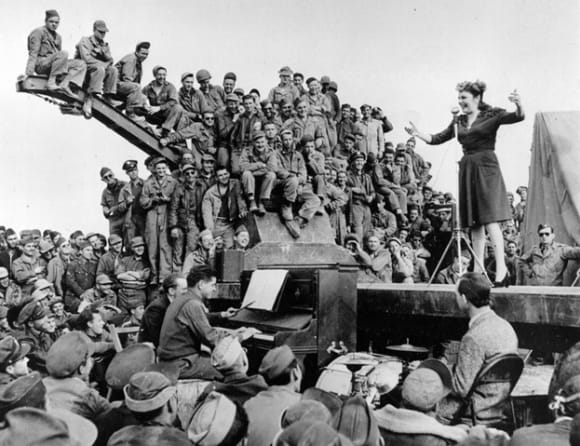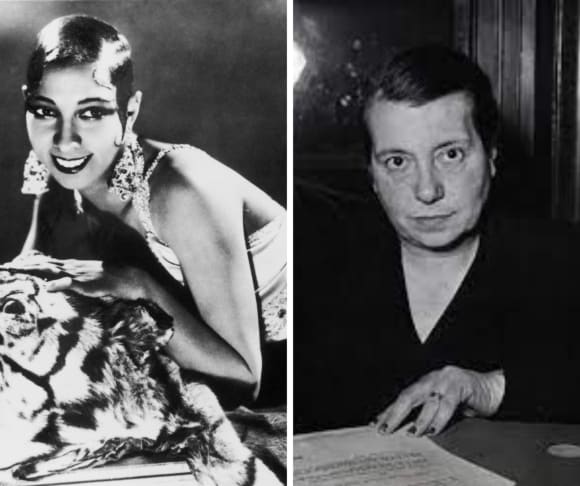The History Behind The Foxhole Victory Tour
Fact: Many USO troupes who performed close to the front lines had near-misses like those portrayed in the novel, including harbor shellings, peril in the skies (even two plane crashes that resulted in entertainer fatalities), and impromptu dives into trenches at the sound of gunfire. Even major stars like Bob Hope weren’t exempt from danger. Reporter Ernie Pyle, in a column covering the touring company’s close encounters with air raids, said, “It isn’t often that a bomb falls so close that you can hear it whistle. But when you can hear a whole stack of them whistle at once, then it’s time to get weak all over and start sweating. The Hope troupe can now describe that ghastly sound.”

Fiction: The Swingin’ Sweethearts is a musical ensemble I created for the purposes of this book, but they would have fit right in during the heyday of “all-girl bands” in the 1940s. Several of the other bands mentioned, such as Phil Spitalny’s Hour of Charm Orchestra and the International Sweethearts of Rhythm were popular at the time, though most disbanded shortly after the war. Their musicians faced many of the same difficulties that Maggie and Catherine did. The first-hand accounts tell of patronization and having to “prove themselves” at best, and outright discrimination and harassment at worst. It was a delight to learn more about these talented women who made their way in the difficult world of show business.
Fact: The WAAC (Women’s Auxiliary Army Corps) did transition to being fully a part of the army in the summer of 1943. The success of overseas companies in particular was a key part of this decision. Officers supervising the postal directory in Algiers marveled, “Since the WAACs have taken over with an entirely different attitude toward the job than the men who had previously handled it, the percentage of errors has decreased materially.” Because of the backlog of work, the women started out working from 8 until 9:30 PM until they’d caught up. First Office Martha Rogers (later Captain) makes a cameo in the novel—she was passed over for advancement at first because the Army didn’t feel she had the right “voice and command,” but she successfully rallied the North Africa WAACs during a time of low morale.

Fiction: As far as I could find, the first USO group to tour North Africa was a collection of four more famous starlets, not one of the lesser-known variety units: Martha Raye, Carole Landis, Mitzi Mayfair, and Kay Francis. Like their fictional counterparts, though, they experienced the rough-and-tumble side of Army life: the hair-washing scene in the novel was inspired by their experiences. Unlike the non-celebrity performers, however, they returned home to great fanfare and a movie deal. Four Jills in a Jeep is a highly romanticized musical-comedy version of their adventures in North Africa. I chose to highlight several (fictional) no-name entertainers because of a quote I ran across by Gordon Fraser, a radio reporter covering life with the troops: “They might not be the biggest names in show business back home, but they’re headliners here, and if you could see the faces of the GIs watching their performance you would see why.”

Fact: A couple of the other real historical figures mentioned in the novel are Josephine Baker and Hélène Benatar. Josephine Baker was a Black American ex-pat who made Paris her home, working to gather intelligence for the French Resistance in France, and later North Africa, during the war. She was well-known for her flamboyant performances and outrageous costumes, but she used her fame as a cover for her spying work, and later to entertain the troops. Hélène Benatar, in contrast, worked behind the scenes. She was a brilliant Moroccan Jewish lawyer who organized multi-faceted humanitarian efforts for refugees from Europe and those freed from the camps set up by Fascist sympathizers in her own country. She fought for the release and legal rights of these prisoners, as well as obtaining practical aid, such as housing and jobs, for those who returned to Casablanca. There’s much more to their stories—Destination Casablanca by Meredith Hindley does a great job of exploring both women’s journey through the war.
Fact and Fiction: Several USO units traveled through Alaska during the Aleutian campaign, which took place from June 1942 and August 1943. The men stationed there endured bitter winters and fierce fighting to retake and defend the territory from the Japanese navy, protecting important trade routes. Most of the USO performances that made their way to them, however, were toward the earlier days of the offensive. For the purposes of the novel’s timeline, I chose to keep my troupe around for the tail end of the campaign.
Wondering about a detail of The Foxhole Victory Tour I didn’t mention here? Feel free to send me an email via my Contact page, and I’ll let you know what’s fact and fiction.